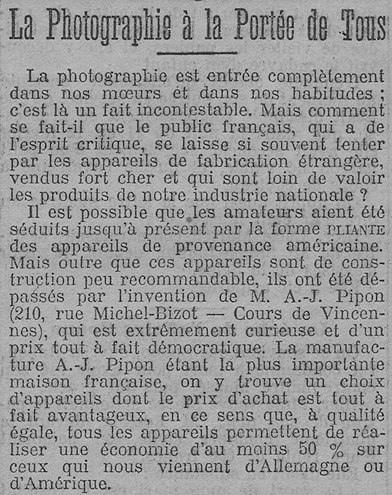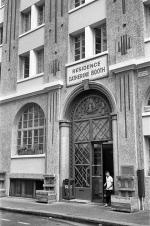|
Pipon The New Cosaque Senior |
Manufactured or assembled in France from (Circa) 1897 to 1902.
Index of rarity in France: Rare (among non-specialized garage sales)
Inventory number: 11157
See the complete technical specifications
Chronology of cameras Pipon
The New Cossack cameras were wooden detective cameras available in the 9 x 12 and 6.5 x 9 formats.
The larger format models were referred to as "Senior," while the smaller ones were named "Junior."
They disappeared from the market at the very beginning of the 20th century, despite being a popular camera type and A-J Pipon being a recognized manufacturer. The explanation for this is provided below.
It's possible that some unidentified camera models found today may be anonymous Cossack cameras, as it is hard to believe that Pipon ceased production, given that only the name was at the heart of the issue.
__________
Le modèle Senior est particulièrement imposant puisqu'au format 9 x 12.
Le mécanisme de réglage de distance et d’obturateur à déclenchement pneumatique est fabuleux.


The Eastman vs. Pipon Lawsuit (from "L'Information Photographique" on January 1, 1902)
By its judgment on December 8, 1900, the Tribunal de la Seine decided that the use of the trademarks "Cossack," "Cossack Junior," etc., to designate photographic cameras constitutes fraudulent imitation of the Kodak trademark.
Sometime later, the Eastman Company circulated a notice stating that although they had not taken action to enforce the judgment thus far, they considered they had given intermediaries sufficient time to remove these cameras from circulation and eliminate them from their catalogs. They invited all merchants to be prepared starting from August 10, from which date they intended to take the necessary measures to enforce the judgment of the Tribunal.
In order to clarify the extent of their responsibility, not only in this case but also in all similar cases, we requested a consultation from the well-known lawyer, Me Bigeon, which we are publishing in full to provide complete information on this matter.
The company "The Eastman Photographic Materials Company Limited," which holds the rights of the Eastman Kodak Company, deposited the Kodak trademark as a factory mark in the records of the Tribunal de Commerce de la Seine. This trademark was intended to be affixed to photographic cameras or accessories of its manufacture, as well as all commercial papers.
The manufacturing company A.-J. Pipon, after the registration of this trademark, put photographic cameras on the market, along with copper and celluloid washers bearing the names "The New Cossack" and "Le Cossack." The Eastman Kodak Company saw this as an act of counterfeiting or fraudulent imitation and obtained a regular seizure at the premises of A.-J. Pipon. Subsequently, they filed a lawsuit against Pipon, seeking damages for the harm caused.
In its judgment dated December 8, 1900, the third chamber of the Civil Tribunal of Seine considered that, in this case, due to the difference between the two marks, the charge of counterfeiting was not valid. However, it declared that there was still fraudulent imitation of the factory mark. This decision was based on the fact that the names "Cossack" and "The New Cossack" applied to A.-J. Pipon's photographic cameras were of such a nature to create clear confusion due to their phonetic similarity with Kodak. According to the judgment, the impression produced by these different words is similar enough that a buyer unfamiliar with both items could easily believe, when accepting a camera named "Cossack" or "The New Cossack," that it was a product of the "Eastman Kodak" company.
For an imitation of a mark to be subject to a civil action for damages, it must be such that it could cause confusion or mistake on the part of the public between the two products. It is not necessary for the cause of confusion to be certain, inevitable, that the buyer is necessarily deceived, or even that they have actually been deceived. In this case, it was clear to the court, based on the facts and circumstances of the case, that the word "Kodak" had been replaced by "Le Cossack" and "The New Cossack" solely to avoid the charge of counterfeiting or imitation, which establishes fraudulent intent to create confusion with the products not only offered for sale but also listed in the plaintiff company's catalog.
Therefore, the Court declared that the manufacturing company A.-J. Pipon was guilty of fraudulent imitation of the factory mark regarding the use of the marks "The New Cossack" and "Le Cossack." Furthermore, it prohibited Pipon from selling photographic cameras bearing these marks in the future and from printing, publishing, or distributing any circulars or brochures mentioning these marks in any way. Additionally, it ordered the destruction of the marks on the seized cameras and of brochures bearing this mark.
The purpose of this article is not to comment on the aforementioned judgment or to provide legal advice on the specific case presented to the court.
A note recently published in the "Courrier du Kodak" raised a more delicate issue. The "Eastman Kodak" Company, addressing certain merchants who were selling cameras bearing the incriminated marks, instructed them, within a specified period, to remove all cameras with the names "Cossack," "New Cossack," "Senior and Junior Cossacks" from both their stores and catalogs, as well as any printed materials of any kind. It declared that if they failed to comply, it would be compelled to take the necessary measures to enforce the judgment of the Tribunal de la Seine.
Affected merchants raised concerns and questioned whether they could face legal action for selling or offering for sale products bearing the incriminated marks. It is important to inform them that there should be no doubt in this regard. The sale or offering for sale, meaning making products available to the public that are counterfeited or fraudulently imitated, is a reprehensible act and even constitutes a crime. Not only are merchants who still have products considered illicit in their stores or in any location accessible to buyers liable for damages, but they also face penalties provided by the law of June 23, 1857 (Articles 7 and 8) concerning trademarks and trade marks. The mere possession of objects bearing these marks, as well as harboring them, falls under the application of general provisions on complicity.
For the legislator, guilt exists in the outward manifestation: "fraud would be limited without the distribution that makes it productive." Thus, selling, whether habitual or isolated, and whether it results in profit or loss, constitutes a punishable act. The same applies to displaying merchandise, exhibiting it in a showcase, or storing it in stores.
It should be noted that these offenses related to the sale of fraudulently imitated products are fundamentally different from the offense of counterfeiting itself; they are only punishable if their authors have acted "knowingly," in the exact terms of the law. Therefore, culpable intent is an essential element, and the accused can claim good faith, in accordance with common law.
The good faith in question is one that legally results from a mistake of fact and not a mistake of law, i.e., the seller's misconception who may have neglected to verify the deposit made, for example. Therefore, it would not be enough to establish the fact; it would have to be proven that the merchant being prosecuted knew that the mark was fraudulently imitated.
Recognizing good faith has several legal consequences: First, it prevents the application of criminal law provisions. Second, it allows dealers to bring a warranty action against the manufacturer in civil courts; this warranty claim would not exist otherwise. However, this excuse does not completely absolve the merchant from civil liability. While not criminally guilty, they have been imprudent. Furthermore, the owner of the imitated mark would be a victim of harm that no one else would repair; therefore, it is fair that they may be entitled to compensatory civil damages.
If the excuse of good faith is accepted, it must be certain that this defense cannot be invoked if the merchant refuses to disclose the source from which they obtained the incriminated products.
Additionally, it is important to note that the confiscation of incriminated goods can be ordered by the court in any case.
Furthermore, it should be observed that in cases provided for by Article 8 of the law of June 23,1837, the injured party is no longer the same as in the cases specified by Article 7 of the same law. It concerns the protection granted to buyers; therefore, it is they, rather than competitors, who can complain of the harm they have suffered or been threatened with.
Finally, in conclusion, it should be noted that a merchant prosecuted for selling products bearing fraudulently imitated marks is entitled, if they can prove that they were misled by their supplier, to take action against that supplier in turn before the criminal court for the crime of fraudulent imitation of a mark.
Armand BIGEOX,
Doctor of Law,
Lawyer at the Court of Appeal of Paris.
In July 1904, one can find in the newspaper Le Radical, this small notice:

It seems that the Pipon brothers have still not endure the loss of the lawsuit.
Interesting links or bibliography :
Add a link or element of bibliography, a picture taken with this camera, a picture of box or an ads about this camera
Your photos taken with the same camera:
Cameras from Ebay France (Pipon) (Uploaded each 3 hours)








